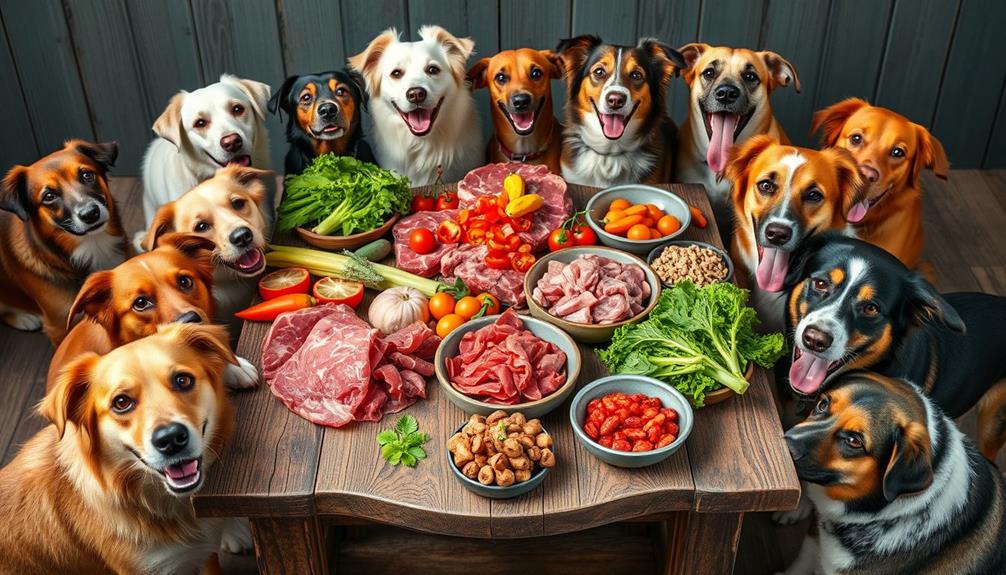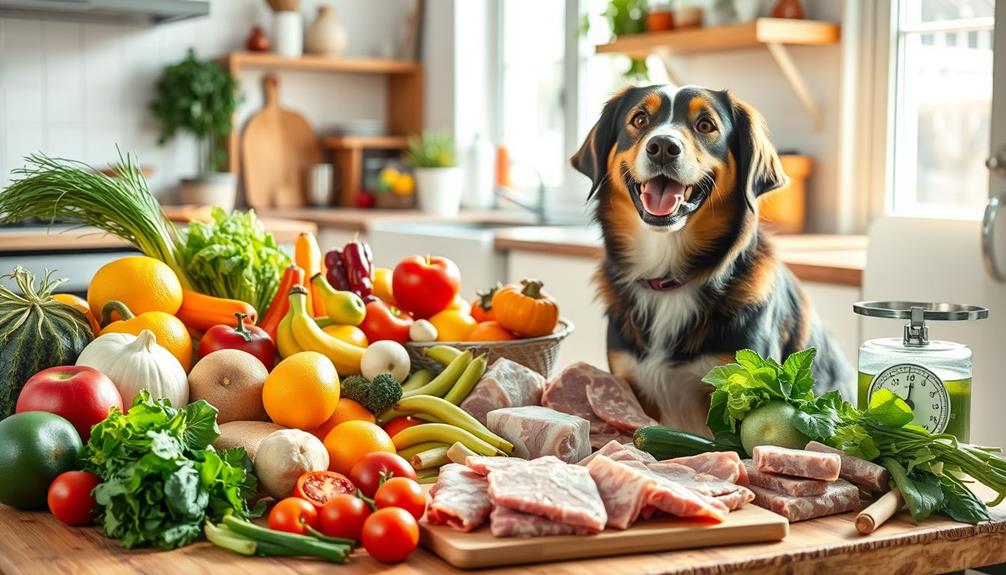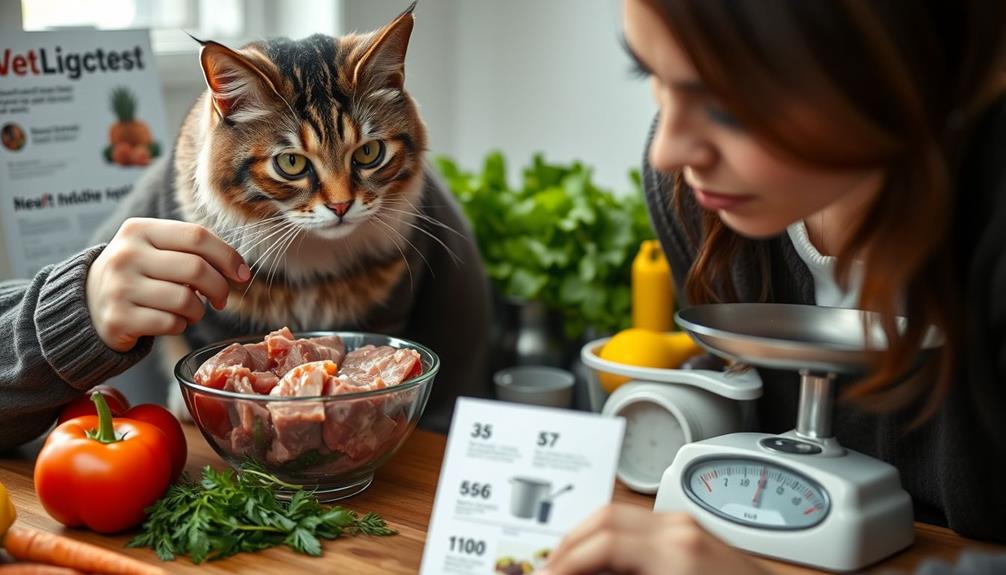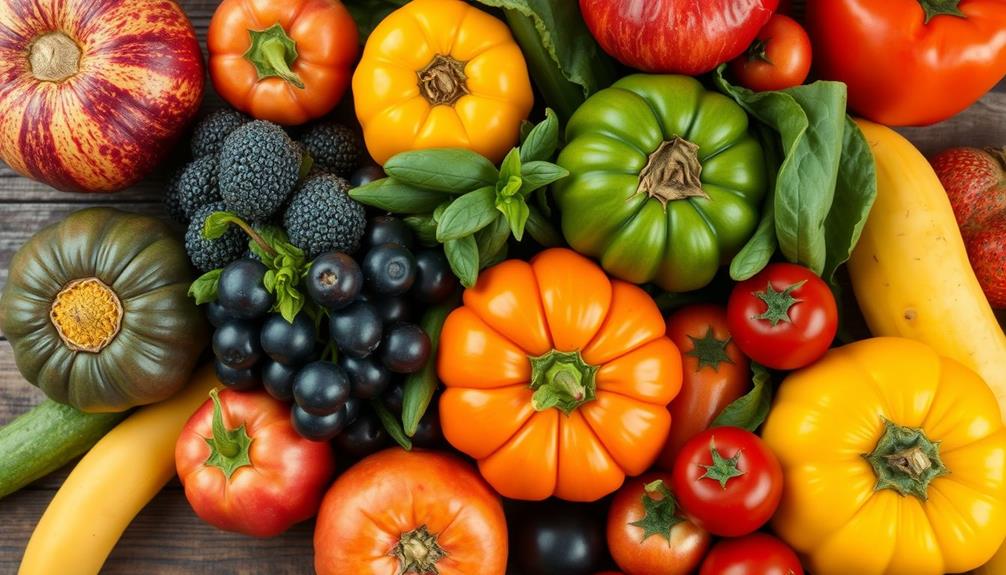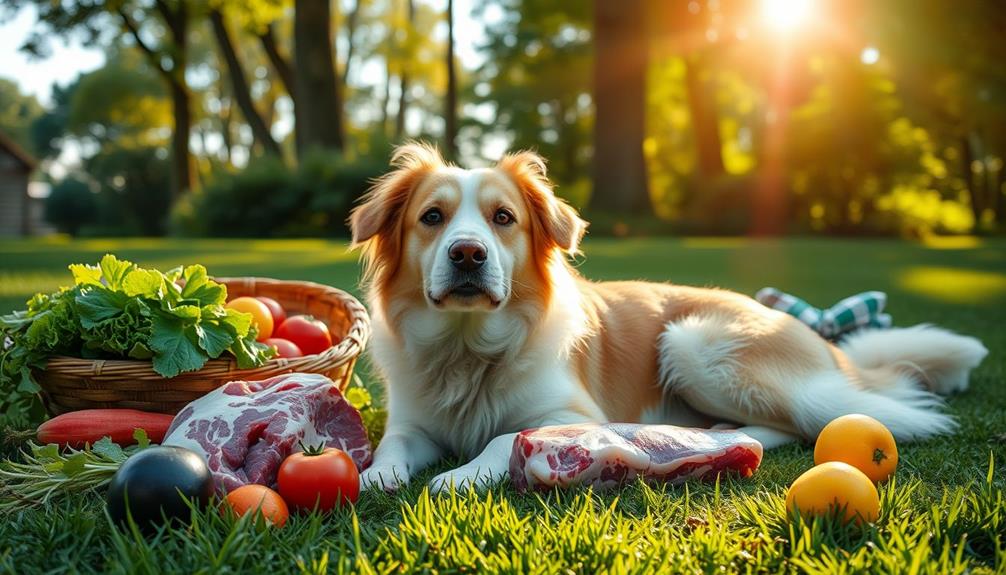Not all dogs like raw food; preferences can vary greatly based on breed, age, and previous diets. Many dogs do enjoy raw meats, especially beef and lamb, but this isn't universal. Factors like sensory experiences and even your own dietary choices play a role in what your dog will prefer. While raw diets have benefits, like better digestion and coat health, there are risks, including potential exposure to harmful bacteria. Understanding your dog's unique likes and dislikes is key. If you're curious about how to navigate these choices, there's a lot more to explore on this topic. If you have a puppy, it’s especially important to be cautious when considering raw food. Puppies have developing immune systems, so they may be more susceptible to any bacteria present in raw meats. It’s crucial to consult with a veterinarian before introducing raw food for puppies, as they have specific nutritional needs that must be met for healthy growth and development. With proper guidance and attention to your puppy’s individual needs, raw food can be a beneficial option for some dogs.
Key Takeaways
- Not all dogs prefer raw food; individual preferences vary based on age, breed, and previous dietary exposure.
- Many dogs show a natural inclination towards meat, often favoring raw diets over cereal-based options.
- Factors like sex, reproductive status, and owner's dietary choices can influence a dog's food preferences.
- Gradual introduction of raw foods can shape a dog's willingness to try new diets and flavors.
- While many dogs enjoy raw food, potential health risks and nutritional imbalances necessitate careful consideration and consultation with a veterinarian.
Individual Dog Preferences
When it comes to dog food preferences, every pup is unique. Your dog's individual dog preferences can greatly impact their enjoyment of meals and overall health. For instance, many dogs tend to favor raw food diets, particularly those rich in beef, pork, and lamb, over poultry options. This preference can vary widely based on factors like age, breed, and even previous dietary exposure.
Additionally, understanding the importance of diversification strategy in their diet can help you provide a well-rounded nutrition plan. As a pet owner, you might notice that your dog's food intake can also be influenced by their sex and reproductive status. Research shows that intact and neutered dogs often exhibit different feeding habits.
Moreover, the quality and type of food you offer—whether it's raw or commercially prepared—can shape your dog's preferences over time.
Don't forget that environmental factors and social interactions play a role, too. Your relationship with your dog can influence their willingness to try new foods or stick to familiar favorites.
Understanding these nuances in canine nutrition helps you provide the best diet for your furry friend, ensuring they thrive and enjoy mealtime.
Factors Affecting Food Choices
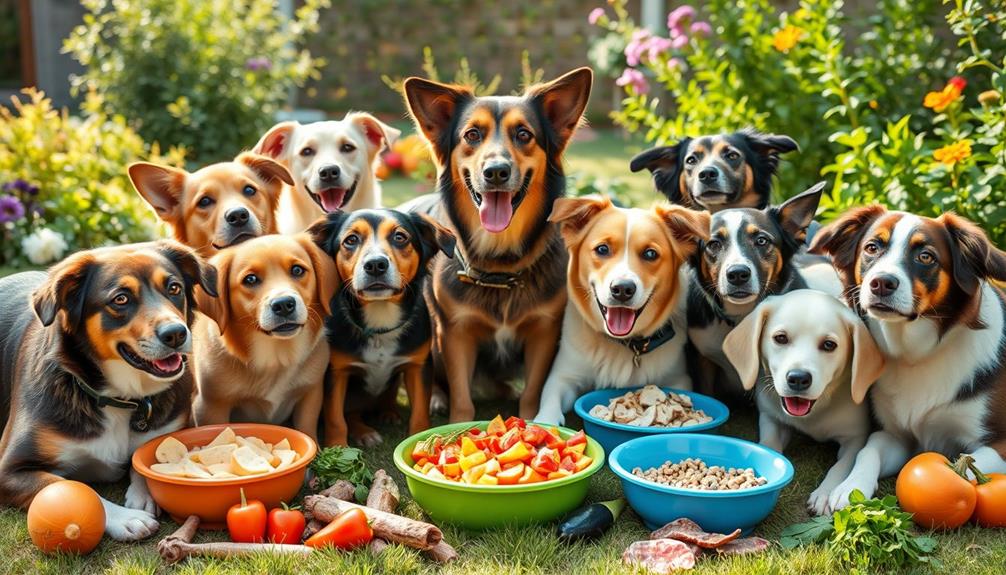
Understanding the factors affecting food choices in dogs is essential for providing a diet that meets their needs. Several elements influence your dog's preferences, such as their sex, reproductive status, and weight. Some dogs naturally gravitate towards meat, showing a clear preference over cereal-based diets. Incorporating healthy dog snacks can also positively impact their diet and overall health.
Your relationship with your pet plays a significant role too. Dogs often mirror your inclinations, making it crucial to be mindful of your own dietary choices. Sensory experiences are also critical; the taste, texture, and odor of food can greatly influence what your dog enjoys.
Additionally, environmental factors—like their physical surroundings and social interactions—can affect their food preferences. For example, a dog might be more inclined to try raw food if they see you enjoying it or if it's presented in a stimulating setting.
As a dog owner, being aware of these factors can help you avoid nutritional imbalances in your dog's diet. Many owners have started incorporating raw food, reflecting a trend towards more natural feeding practices. Understanding these influences can guide you in selecting the right food that aligns with your dog's preferences.
Benefits of Raw Diet

When you consider a raw diet for your dog, you might notice significant nutritional advantages that can enhance their overall health.
These nutrient-dense foods not only support better digestion but also help your furry friend absorb essential nutrients more effectively.
Additionally, incorporating a variety of proteins and fresh vegetables can provide a well-rounded diet that aligns with your dog's natural instincts and dietary needs, which is often highlighted in a cold medications overview.
As a result, you could see improvements in their vigor and energy levels.
Nutritional Advantages
A raw diet can offer considerable nutritional advantages for your dog, delivering a wealth of benefits that promote overall health. By incorporating raw food, you're providing your pet with nutrient-dense options that can enhance their well-being.
The high moisture content of raw food can also support hydration and urinary tract health, which is essential in preventing potential kidney-related issues, similar to how cranberry juice consumption may help in kidney stone prevention.
- Boosts energy levels
- Improves coat health
- Reduces allergy symptoms
- Supports muscle mass
The benefits of raw diets stem from the inclusion of fresh food like meats, bones, fruits, and vegetables, which aim to mimic your dog's ancestral dietary habits. This approach not only promotes ideal health but also guarantees they receive essential amino acids and fatty acids important for bodily functions.
Moreover, raw food's high moisture content can aid in hydration and urinary tract health, potentially lowering the risk of kidney-related issues.
By choosing dog foods rich in natural, unprocessed ingredients, you're setting the stage for fewer allergies and better overall health. Embracing a balanced raw diet can greatly enhance your dog's nutritional profile while supporting their digestive system effectively.
Consider these nutritional advantages as you explore feeding options that align with your dog's health needs.
Enhanced Digestive Health
Raw diets not only provide nutritional advantages but also greatly enhance digestive health in dogs. By feeding raw food, you may notice your dog experiencing fewer digestive issues like bloating and gas. The high nutrient density of uncooked meats, bones, fruits, and vegetables helps promote healthier gut flora, leading to improved energy levels and liveliness.
Additionally, a balanced raw diet aligns with your dog's ancestral feeding habits, potentially improving overall digestive function. The natural ingredients in these diets for dogs are often easier to process compared to commercially available raw or processed foods. Furthermore, raw diets stimulate natural chewing behavior, which contributes to dental health and reduces plaque buildup, further supporting enhanced digestive health.
Here's a quick overview of the benefits:
| Benefit | Description |
|---|---|
| Nutrient Density | Supports ideal digestion and nutrient absorption |
| Healthier Gut Flora | Promotes improved energy levels and liveliness |
| Reduced Digestive Issues | Less bloating and gas due to easier processing |
| Dental Health | Stimulates chewing, reducing plaque buildup |
Incorporating these elements into your dog's diet can lead to a happier, healthier pet.
Potential Risks of Raw Feeding
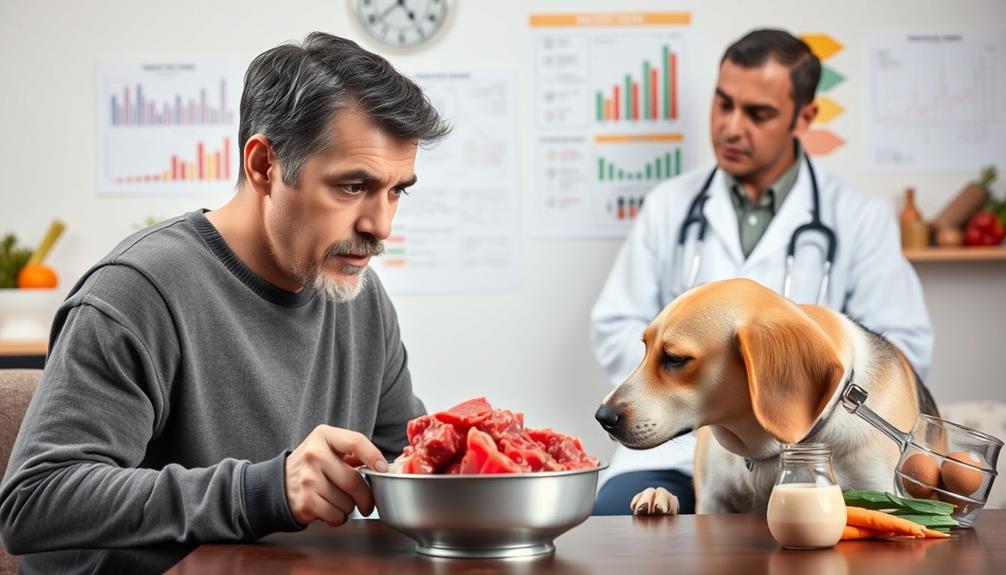
Feeding your dog a raw food diet can seem appealing, but it comes with significant health risks that shouldn't be overlooked. The potential for contamination isn't just limited to your dog; it can affect everyone in your household, particularly vulnerable populations. Here are some key concerns to take into account:
- Pathogen Presence: Nearly 25% of raw food samples test positive for harmful bacteria like Salmonella and Listeria monocytogenes.
- Human Health Risks: Salmonella infections lead to about 1.2 million cases annually in the U.S., resulting in roughly 400 deaths.
- Vulnerable Populations: Listeria can cause severe illness, especially in newborns, the elderly, and pregnant women.
- Nutritional Imbalances: Raw diets may lack essential nutrients, leading to deficiencies and gastrointestinal issues.
While raw feeding might seem like a natural choice, be aware that dogs can carry Salmonella asymptomatically, putting at-risk individuals in your home in danger.
Additionally, the nutritional composition of raw diets often requires careful planning to guarantee your dog gets the balanced diet they need.
Financial considerations related to pet care should also be factored into your decision-making process.
Ignoring these risks can lead to serious health issues for both your dog and your family, making it essential to weigh the benefits and drawbacks before committing to a raw food diet.
Comparing Raw and Cooked Diets
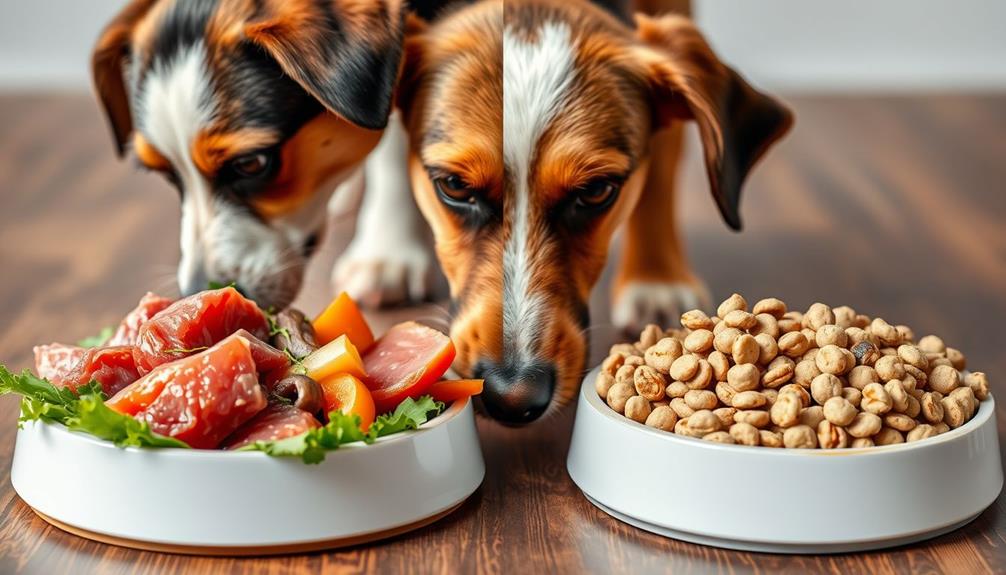
When considering the best diet for your dog, comparing raw and cooked options reveals distinct advantages and drawbacks. A raw diet often appeals to pet owners because it aligns with dogs' nature, focusing on high protein content found in raw meat. About 16.2% of dog owners have started incorporating raw food into their pets' diets, reflecting a growing interest in this method.
However, maintaining nutritional balance can be challenging with raw diets, as they may not meet all dietary needs. Additionally, just as with piercing care and hygiene, ensuring proper food handling and preparation is essential to avoid health risks associated with raw feeding.
On the other hand, cooked meat offers enhanced safety by considerably reducing the risk of bacterial contamination, a common concern with raw feeding. Cooked dog food allows for tailored meal preparations, making it easier to meet specific dietary requirements, which a veterinary nutritionist would likely recommend.
Additionally, cooked diets often provide better digestibility, making them easier for your dog to process. While raw food can promote natural behaviors and improve satiety, cooked diets are generally more convenient for pet owners to prepare consistently.
Ultimately, the choice between raw and cooked diets should consider your dog's unique needs and your ability to maintain a balanced diet.
Making an Informed Decision
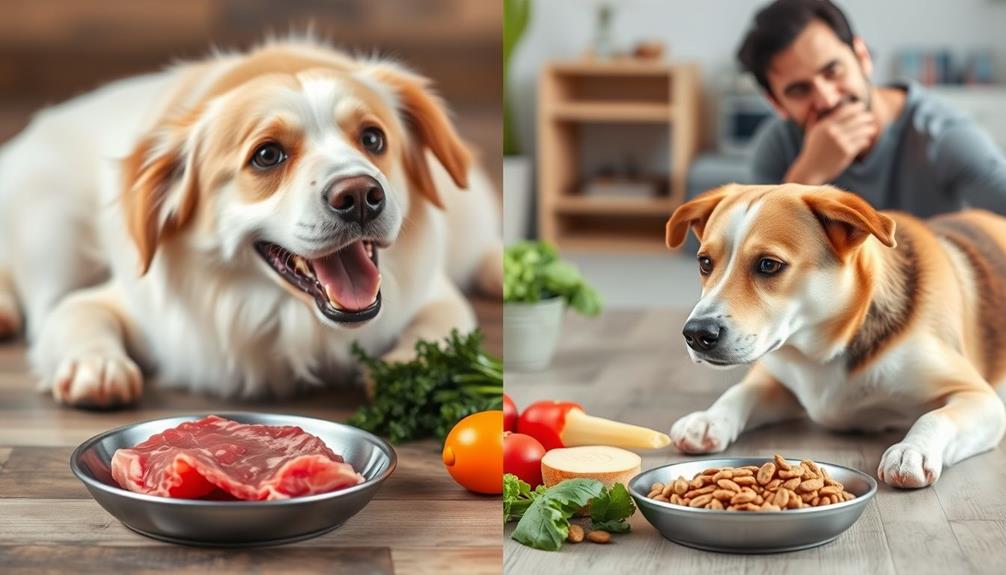
When choosing a diet for your dog, you need to evaluate their individual dietary needs and any health concerns they might have.
Just like with hamsters, understanding a pet's proper diet is vital for their well-being, and proper diet guidelines can provide valuable insights.
Shifting to a raw food diet can come with risks, so it's important to weigh the benefits against potential issues.
Consulting with a veterinarian can help guarantee you make the best choice for your furry friend.
Individual Dietary Needs
Understanding your dog's individual dietary needs is vital for their overall health and well-being. Each dog is unique, and factors like age, breed, activity level, and health status can markedly influence their nutritional requirements.
When considering raw food diets, keep these points in mind: Dogs may prefer certain protein sources, such as beef or lamb, over others like chicken or liver. Additionally, just as with investing, it's important to assess the potential risks and rewards of raw diets for your dog, including the significance of balanced nutrition understanding dietary risks.
AAFCO guidelines emphasize the importance of complete and balanced nutrition, which can be tricky to achieve with raw diets. Consultation with a veterinarian or pet nutritionist is vital to guarantee that your dog's specific nutritional needs are met.
Dogs' preferences can be shaped by what you feed them and how you introduce new food options.
Health Considerations and Risks
Health considerations and risks are vital factors to weigh before choosing a dog food diet. While raw food diets can be appealing, they carry significant health risks. Health authorities like the CDC and FDA warn that nearly 25% of raw food samples can test positive for harmful bacteria, including Salmonella and Listeria monocytogenes.
These bacteria can lead to severe illness not just in dogs but also in humans, particularly affecting vulnerable populations such as children and the elderly. Additionally, just like the importance of early detection in breast cancer through mammography guidelines, making certain that your pet's diet is safe is essential for their health.
Dogs can carry Salmonella and Listeria without showing any symptoms, which poses a risk to you and your family. To mitigate these risks, practicing stringent hygiene and food handling measures is vital during pet feeding. Furthermore, raw diets may lack essential nutrients, leading to potential nutritional deficiencies and gastrointestinal issues.
Before making any decisions, it's wise to seek consultation with a veterinary nutritionist. They can help assess your dog's specific health needs and make sure that any diet you choose is balanced and safe.
Ultimately, being informed about these health considerations will help you make the best choices for your furry friend.
Frequently Asked Questions
Do Some Dogs Not Like Raw Food?
Yes, some dogs don't like raw food. Their preferences can depend on factors like breed, age, and past diets. If they're used to kibble, they might not be open to trying raw options.
Do Picky Dogs Like Raw Food?
When it comes to picky dogs, you'll find they often have a taste for raw food, thanks to its enticing aroma and texture. However, it is crucial to observe each dog's unique preferences and reactions.
Do All Dogs Do Well on a Raw Diet?
Not all dogs do well on a raw diet. Individual needs vary, and some may face gastrointestinal issues or nutritional imbalances. Always consult your veterinarian to determine the best diet for your dog's unique health requirements.
Why Are Vets Against Raw Diets?
Like a chef wary of foodborne illness, vets caution against raw diets due to bacterial risks and nutrient imbalances. They recommend balanced commercial options to keep your furry friend healthy and thriving.
Conclusion
Ultimately, not all dogs will enjoy a raw food diet, and that's okay! Just like us, each dog has unique tastes and preferences. Have you ever seen your pup turn up their nose at a meal you thought they'd love? It's essential to take into account your dog's individual needs and consult with a vet before making any changes. By understanding your dog's preferences, you can guarantee they're happy and healthy, no matter what type of food you choose. If you’re considering a raw food diet for your dog, it’s also important to consider their digestive health. Some dogs may have sensitive stomachs and struggle to process raw foods effectively. In these cases, it’s crucial to explore other dietary options or seek out specialized raw food for sensitive stomachs. By being attentive to your dog’s needs and consulting with professionals, you can ensure that they receive the best possible nutrition for their unique requirements.

